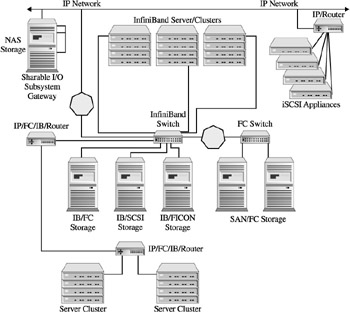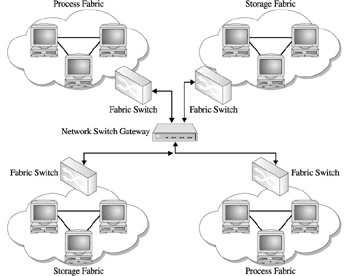Connecting to the Future
| |
Over and above the connectivity of SAN into existing data center infrastructures , SAN will soon need to integrate into the continuing evolution of external processing technologies, such as advanced clustering, InfiniBand, and blade -level computing. Each of these will require the SAN to address the compatibility issues of how the FC network interfaces with these evolving technologies.
Clustering has been an emerging solution for highly available configurations and is now employed to address availability levels for real-time transactional workloads. Although clustering solutions utilize the SAN in an effective manner, the ability to support both sides of a cluster is problematic , causing most configurations to support two distinct SAN configurations, which provides two distinct system images, with a SAN fabric supporting each.
The consideration regarding these configurations is the expense in doubling the processing environment to ensure that upon failover the supporting system can take over the workload and synchronize the data and continue processing. Secondly, the protocol used to communicate between the two systems, TCP/IP, adds quite a large overhead for the short communication paths between servers. Finally, the complexities of synchronizing the databases and data for continued processing upon recovery makes these solutions expensive and difficult to configure and maintain.
Look for clustering to take advantage of two systems sharing the same fabric, reducing the complexity of totally discrete systems to failover at the processing level with shared SAN access. This allows the data to be protected through a RAID-level mirror within the SAN, should it be needed at the storage level. Additional protection for hardware and data redundancy within the SAN configuration provides for failure recovery within the storage infrastructure, as shown in Figure 16-8.

Figure 16-8: Advanced clustering with shared storage SAN
If we take our clustering discussion and replace the system-to-system communications (now using TCP/IP) with a switched fabric network implementation using the InfiniBand protocol, we begin to see the benefits of InfiniBand. Let's take that one step further and implement a fabric-to-fabric interconnection, tying our SAN configurations together. Now we're really seeing the benefits of InfiniBand.
An InfiniBand configuration allows system-to-system communications to scale beyond the current 2-, 4-, or 8-way clusters that are expensive and unwieldy, but nonetheless available, and replace this with low-cost process node servers communicating through a switch fabric. This allows an infinitely larger number of servers to effectively communicate. In addition, the ability to tie in storage devices, such as the SAN, through an InfiniBand fabric to FC fabric interconnection allows some or all the servers to share the storage resources being managed by the SAN fabric.
InfiniBand technology allows for the creation of both a process infrastructure and a storage infrastructure, each with the capability to communicate though a common scalable interconnect in order to develop a dense computing and storage fabric.
If we take our Infiniband and FC SAN fabrics and key in on the process nodes, the application of a switched fabric internal to the process node provides yet another scalable resource within the process fabric. The use of internal switched fabrics , such as Rapid I/O and HyperTransport, form a foundation that allows internal components of the process node to scale new heights, bumping up the number of CPUs and addressable storage levels.
Given this configuration, we can begin to visualize the requirements for an internal storage function within the process fabric to support the internal functions of the process node. The communications between storage and process fabrics are enabled by the InfiniBand protocol.
In conclusion, network technologies will continue to decouple the traditional computing configurations into process and storage networks. The data center is headed toward the next level of computing, driven by storage area network technologies that support all aspects of application sets and process environments: business, academic, scientific, and personal. The future data center is likely to become a logical set of storage and process fabrics, as illustrated in Figure 16-9, communicating through a public and private network infrastructure.

Figure 16-9: The future: process and storage fabrics with a common interconnect
| |
EAN: 2147483647
Pages: 192
- Challenging the Unpredictable: Changeable Order Management Systems
- ERP System Acquisition: A Process Model and Results From an Austrian Survey
- Enterprise Application Integration: New Solutions for a Solved Problem or a Challenging Research Field?
- Data Mining for Business Process Reengineering
- A Hybrid Clustering Technique to Improve Patient Data Quality